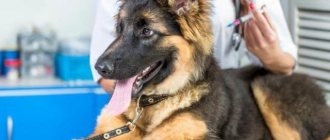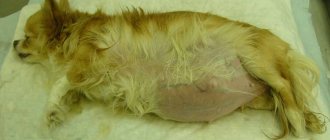At what age can you start feeding puppies complementary foods?
When answering the question of when you can feed puppies, veterinarians and dog experts are of the opinion that it is best to start at three weeks. Undoubtedly, mother's milk is the best food for still immature newborn puppies, but after a few weeks they are ready to get acquainted with the world around them. The ideal age to start feeding small puppies is from three weeks, or even two.
Proper diet is very important for a puppy
In this matter, it is extremely important not to rush or be late. In the first case, the mother will reduce the amount of breast milk she produces, causing the entire litter to be malnourished. In the second case, delayed complementary feeding entails a slowdown in the growth and development of the body; such pets often grow up sick and weak.
How to wean puppies off their mother's milk
Small breed food for puppies as well as large and medium breeds
Weaning puppies from their mother is recommended from 6 weeks of age. Typically the deadline is 8 weeks. You can calmly separate puppies from their mother only if they are already consuming the daily amount of food on their own. These are the dates they focus on when deciding when to start feeding puppies correctly.
The peculiarity of weaning is this: for the first two or three days, the pets are left with the usual amount of food, after which they begin to gradually increase it to the required levels.
Assortment of food for puppy's first feeding (starters)
Important! Rapid weaning of the litter from a bitch while simultaneously reducing the amount of food she consumes leads to a reduction in milk production and also serves as a preventive measure for the development of mammary gland diseases.
Feeding puppies
This topic is for those who decided to start breeding dogs and finally got their first litter. We will talk about how to properly feed children, providing adequate nutrition and not harming their health.
Puppies begin their first feeding no earlier than two weeks of age. The puppy’s digestive system is still only suitable for digesting mother’s milk, so there is no need to rush. From two weeks they begin to feed the babies if the bitch has little milk or the litter is multiple and there is not enough food for everyone. There is one caveat here. There are ways to increase your bitch's milk production, you need to try them first. A lactating bitch needs to be fed as much as she can, that is, as much as she can eat. Fresh water must always be available! Fresh goat milk and fermented milk products increase productivity well. It is useful to add honey to goat milk, about 1 teaspoon per liter. I don’t recommend giving cow’s milk - it causes indigestion in most bitches, and it certainly won’t increase milk production.
Some breeders, even more or less experienced ones, recommend injecting oxytocin to increase milk production. Personally, I am categorically against such a decision. Oxytocin is a hormonal drug, and even if milk production increases, such food is very harmful for puppies. It's better to start complementary feeding earlier.
If circumstances force you to start feeding puppies at the age of two weeks, the best solution would be to buy a ready-made bitch milk substitute. Other foods at this age will not yet be able to be properly absorbed.
If the bitch has enough milk, the puppies do not go hungry, do not squeak, and are gaining weight well, complementary feeding should begin at three to four weeks. I start complementary feeding with raw meat. No other product contains as many nutrients as meat. Especially,
Source
What should be the portion size for a puppy?
It is important not only to know when it is time to start feeding your puppies, but also to learn the correct portion sizes.
When can you bathe a puppy for the first time without vaccinations?
The feeding rate for a still small dog’s body depends on several factors – the individual characteristics of the body, the breed. It is extremely important to correctly calculate the volume of portions, since a deficiency of feed will inhibit growth and development, and an excess will cause the development of diseases of the digestive and cardiovascular systems.
The optimal amount of food can be calculated based on the puppy's body weight. The daily intake of a baby up to 6 months is no more than 7% of its weight. After this period of time, the volume of food is reduced to 3-4%.
For your information! While making adjustments, the pet may not eat everything; perhaps he is simply full or he does not like a certain product.
Basic natural foods for a growing body:
- offal and natural meat;
- dairy and fermented milk products;
- healthy supplements;
- cereals;
- dry food of the highest and highest quality;
- vegetables;
- fish.
How to calculate the volume of portions for a puppy (calculation formula)
The feeding rate can also be calculated experimentally; you just need to carefully monitor the baby. If the puppy not only eats everything, but also carefully licks his dishes, then he is hungry. If there is food left in the bowl, then the puppy is given more than normal.
If food refusal is prolonged, this is a cause for concern. The puppy needs to be seen by a veterinarian as soon as possible.
Features of the puppy's diet
The daily diet for puppies from 1 to 12 months is compiled taking into account age and physiological needs. In order for babies to have enough strength and energy, they need to eat a lot, but their stomach is still too small, so the daily portion should be divided into 5-6 meals. The products must be fresh, since the digestive system is still very sensitive: it reacts sharply to any errors in nutrition.
Puppies need a large amount of proteins, vitamins and microelements, while their excess can be harmful to an adult animal, so food for puppies and adult dogs differs significantly from each other.
To ensure your pet grows healthy and energetic, follow these recommendations:
- create a feeding schedule;
- give food at room temperature;
- if the puppy does not eat the entire portion at one time, you need to make it smaller;
- place the bowl at chest level to avoid problems with posture;
- Make sure your pet always has clean water;
- if one feeding is missed, there is no need to double the next portion: continue feeding as usual;
- the daily diet should consist of 2/3 protein foods;
- Portions should be calculated based on weight and age, not height.
Owners can buy ready-made dry food for puppies or create a daily menu from natural products. The first option is more expensive, but less troublesome.
First food for a small dog
Starting to feed puppies is a serious matter, since during the period of active growth and development, the pet’s body must be provided with a minimum but necessary complex of vitamins, minerals, macro- and microelements.
When can you walk your puppy after the second vaccination?
Having figured out when you can start feeding puppies, it is important to decide on its composition. It is recommended to give preference to the food that will be introduced into the diet in the future on an ongoing basis. If preference is given to natural nutrition, then the diet consists of healthy and nutritious foods suitable for the puppy.
Note! Each breed, for example, Jack Russell, Yorkshire Terrier, Labrador, Laika, German Shepherd, Toy Terrier, Husky, Chihuahua, Spitz and others, has individual characteristics in the functioning of the digestive system. You need to not only know them, but also take them into account when planning your diet.
Products of the first natural complementary food for a puppy
It is impossible to create the most balanced, fortified natural product at home, so additional vitamin and mineral complexes must be introduced into the diet. That is why many dog breeders prefer ready-made industrial dry or wet food of the highest and highest quality.
Important! A special dry food, designed specifically for this purpose, is ideal for the role of first complementary food. It's called a starter.
Dry food and canned food
Ready-made food is balanced with all nutritional components necessary for normal growth and development of pets. In addition, they are very convenient to use. If the owners choose to eat industrial food, then they buy special food for puppies from the “Starter” line. It contains more vitamins, macro- and microelements. Puppy food is not suitable for an adult dog, as it no longer requires such a large amount of vitamins. In high doses they cause disturbances in the functioning of the body.
Specialized food for husky puppies contains high fat and low carbohydrates.
Feeding with dry food begins once a day. The serving size is several granules. Over the course of a week, the amount of granules is gradually increased. Up to 6-8 months, dry food granules are soaked in warm water, kefir, milk or meat broth.
After six months, the pet is transferred to ready-made food with a reduced protein content, no more than 25% of the composition. These feeds belong to the “Junior” class.
When feeding dry food, puppies should always have fresh water freely available.
When choosing food, take into account the following parameters:
- meat should come first in the ingredients;
- for huskies, beef, chicken, lamb are suitable;
- fish feed alternates with meat;
- the feed must contain vitamin E, which is used as a preservative in high-quality feed;
- food should not contain soy, corn, artificial colors, preservatives, or flavors.
Only premium and super premium food meets these requirements, including Eukanuba, Hill's, Orijen, Acana, Royal Canine, Happy Dog and others. Cheap products contain a lot of starch. The husky's gastrointestinal tract does not tolerate it well.
Canned food is usually mixed in small portions with dry food to diversify the diet.
What and how to give puppies after one month of age
The schedule and mode of feeding your pet directly depends on its age. At different stages of growth and development, a dog’s body needs certain substances. This must be taken into account when planning your diet.
During the period of 1-2 months, the puppy experiences an acute need for calcium. This macronutrient is necessary for the body for proper skeletal development. That is why the daily diet should consist of approximately 40-50% dairy products. You can introduce kefir, sour cream or cottage cheese into your diet.
Note! It is better not to give fruit yoghurts and other dairy products that contain dyes and flavor enhancers.
In addition to dairy products, your pet also needs fresh meat. Per day, as a percentage, it should be at least 40%. It is recommended to give preference to boiled poultry or raw beef. You should definitely give up fatty pork. The remaining 10-20% consists of fresh vegetables and fruits.
How to give?
For adult dogs
If baby food was included in the diet, it is best to give it no more than twice a week, as a treat or added to other foods.
Before choosing such food, you should familiarize yourself with the list of prohibited foods for dogs. Foods that are harmful to dogs are: raisins, garlic, onions, grapes, etc. Therefore, you need to carefully study the composition.
Important! In order not to harm your pet, you need to carefully read the composition and follow the instructions.
For puppies
Nowadays, there are many different analogues of dog milk, but infant formula can also be used. It is worth considering that puppies have very weak immunity, so you must follow all the rules of admission and correct feeding.
Prepare this mixture in certain proportions:
- 0.5 liters of milk;
- 1 raw yolk;
- liquid vitamins;
- sometimes, if desired, add a spoonful of honey or 40% glucose.
When feeding this way, they usually keep a diary in which they record information about the amount of food consumed and the growth of the babies. Such a diary is filled out daily for each of the puppies, and they are weighed every three days.
The frequency and feeding of puppies with infant formula directly depends on the age of the babies and their well-being.
Newborns
A puppy can be fed this mixture from birth, but only if there are no other options left. Receiving the right amount of food and not getting sick, its growth will increase according to the following scheme:
- a week after birth, the weight will increase 3 times;
- in two weeks it will increase 5 times;
- after three weeks – 7 times;
- at the age of a month, the puppy's weight will be 10 times different from the weight when it was born.
The number of feedings from the 1st to 10th day is 10-12 times a day, from the 10th day you can reduce it to 8 feedings, and from three weeks the puppy should receive 6 feedings a day.
The first feeding should be done around 6 am, and the last one as late as possible - at 10 pm. The mixture must be at room temperature and fresh, otherwise the baby may become ill and die.
Diet from six months to a year
As puppies grow older, their diet must be changed. It is necessary to gradually increase the amount of meat, reducing the amount of dairy products. At the age of six months, a dog should eat about 70% of the total food per day.
Important! From 4-6 months, depending on the breed, the animal can be given offal. We are talking about the liver, spleen, heart and lungs.
From six months of age, you can also start giving your pet fish in small quantities. Preference should be given to marine representatives. Dairy products no more than 20-30% per day, the amount of vegetables and fruits remains the same, and cereals are gradually introduced.
If the animal is fed with ready-made industrial formulations, then it is necessary to choose certain types, the packaging of which contains notes about the appropriate age.
Scheme of complementary feeding with natural food
Daily diet with natural nutrition
Puppies' nutrition should be appropriate for their age and weight. In order not to cause problems with the digestive system, it is necessary to change the diet and increase the daily amount of food during natural feeding gradually.
Every day, the baby should receive a sufficient amount of proteins, fats, carbohydrates, vitamins and microelements for his age. A young pet should not overeat, so it is very important to follow the puppy’s feeding schedule.
From one to two months
A one-month-old puppy needs to be fed 6 times a day every 3 hours. Veterinarians advise adding a teaspoon of fish oil to food several times a week: it has a positive effect on dogs’ hearing, vision and nervous system. At week 5, puppies should already try cottage cheese and meat. Gradually you can add chopped vegetables: carrots, pumpkin, herbs. Feeding dry food to puppies under 6 weeks of age is not recommended.
Example of a daily menu:
- Calcined cottage cheese.
- Oatmeal with milk and carrot pieces.
- Milk or kefir.
- Second portion of porridge (you can replace carrots with pumpkin).
- Bioyogurt.
- Finely chopped fillet of meat or fish.
Monitor your baby's reaction to certain foods: if something on the menu causes stomach upset, temporarily remove it from the diet.
From two to four months
At this age, puppies begin to be sold, so they must completely switch to independent feeding. A two-month-old puppy needs to be fed 5 times a day with breaks of 4 hours.
Solid foods should be finely chopped, but not to the point of minced meat, as the dog needs to learn to chew food.
Example of a daily menu:
- Cottage cheese diluted with whey.
- Buckwheat porridge with meat broth.
- Puree of boiled vegetables.
- Low-fat kefir.
- Beef or veal fillet.
By 4 months, dairy products are gradually replaced by protein foods.
From four to six months
Four-month-old pets are fed 4 times a day. You can add boiled liver or lungs to the daily menu; you should also slightly increase the portions according to the weight of the animal.
Example of a daily menu:
- Buckwheat porridge with vegetables.
- Boiled chicken liver.
- Boiled egg.
- Beef fillet.
At this time, dogs are changing teeth, so you can give them a marrow bone or rye bread crackers to chew on.
From six to ten months
From the age of six months, you need to feed the puppy 3 times with an interval of 6 hours. By this time, dairy products are completely removed from the diet. Every day the pet should receive 50% meat, 25% vegetables and 25% grains.
Example of a daily menu:
- Brown rice porridge with carrots.
- Boiled chicken hearts.
- Chicken fillet.
Pieces of fruit can be given as a treat between meals, but not citrus fruits.
From ten to twelve months
By the age of one year, the dog should switch to two meals a day: morning and evening. Portions should be increased taking into account the weight of the pet. You need to alternate meat and fish, various cereals, vegetables and fruits in the menu.
Complementary feeding scheme using dry industrial feeds
Most veterinarians are of the opinion that it is better to feed puppies natural food until they are three months old. However, for a number of specific reasons, dog owners often prefer dry food. Ready-made food intended for puppies is pre-soaked in water so that the kitten quickly gets used to the innovations.
Note! Leading feed manufacturers try to make their formulations as balanced and nutritious as possible.
The packaging always contains information about the daily amount of food depending on the weight of the pet.
Scheme for feeding puppies on dry industrial food
If preference is given to dry food, then the puppy should have unlimited access to clean drinking water.
Dosage and organization of diet
Calculating a portion of dry food for a puppy is very simple: the packaging of any brand of food contains a table of the manufacturer’s recommended daily intake. In puppy food, in addition to weight, its age in months or weeks is also taken into account - you can read more about the correct dosage of dry food for puppies in this article.
The daily portion of food should be divided by the number of feedings. The younger the puppy, the more often you will have to feed him - the quality of food absorption depends on this, and fractional feeding also helps maintain the optimal energy level for an actively growing baby.
It is unacceptable to forget about providing a growing pet with fresh drinking water - it must be available 24 hours a day. The water should be renewed as often as possible, since the animal’s saliva and food particles get into the bowl, which create an environment favorable for dangerous bacteria.











